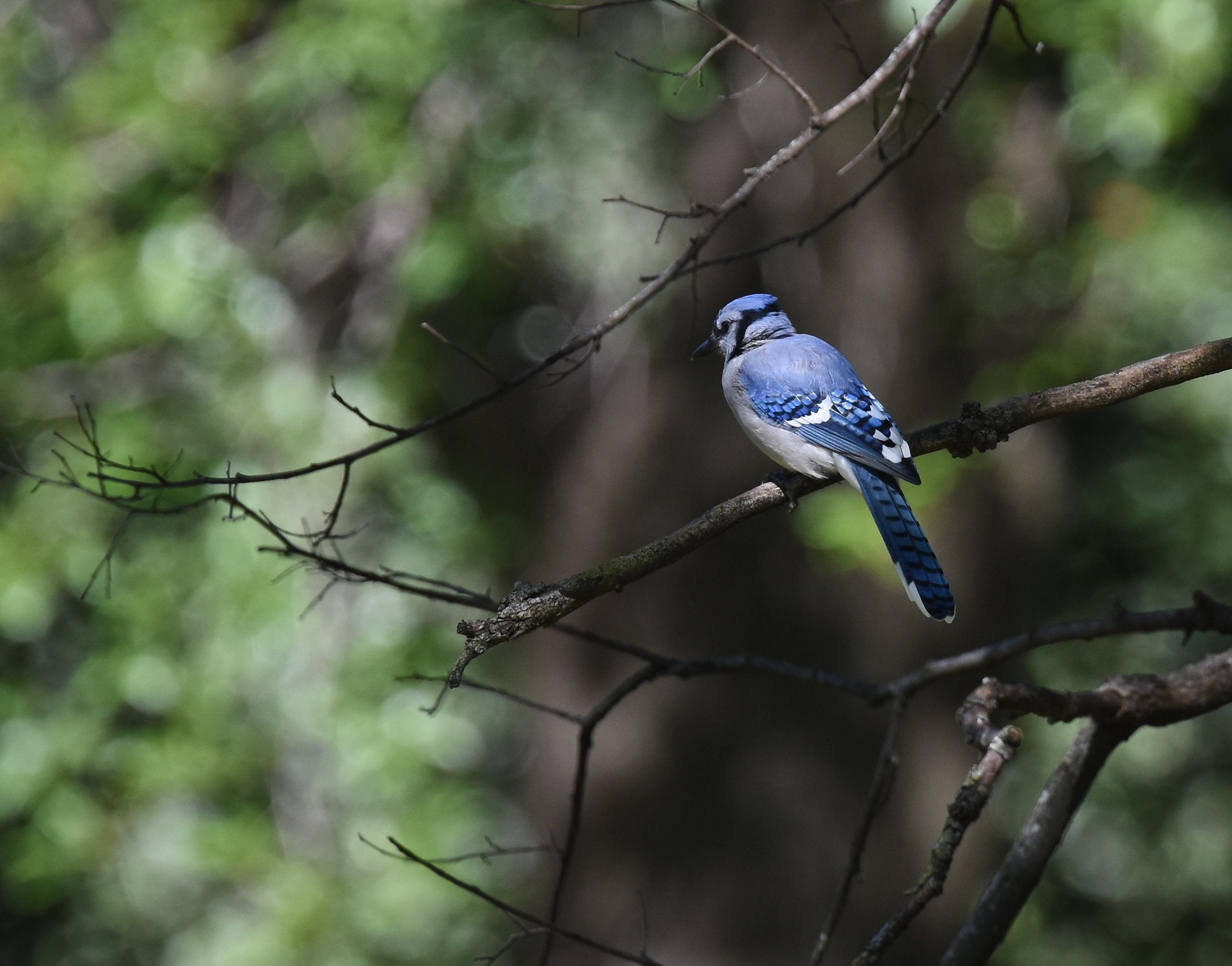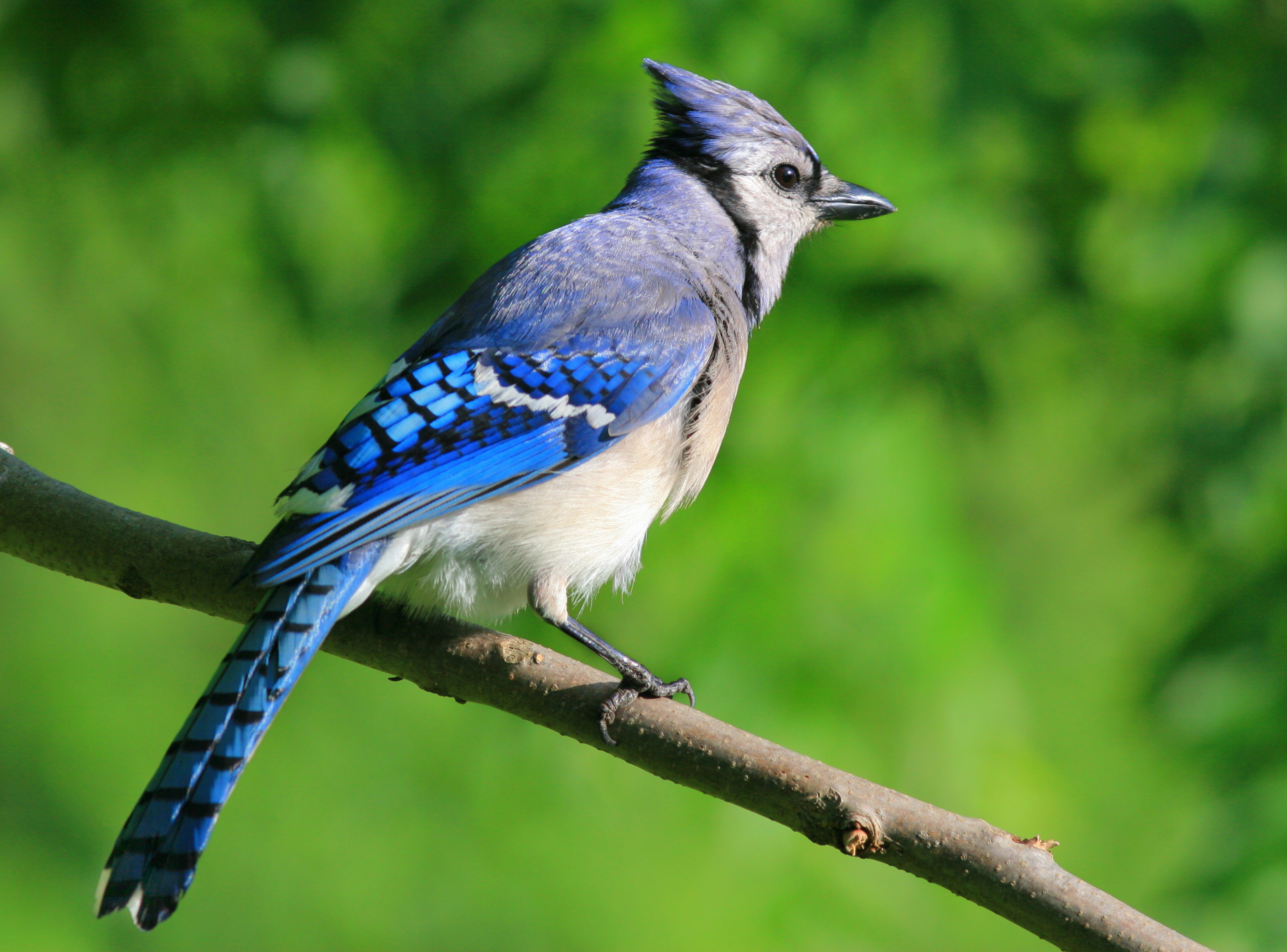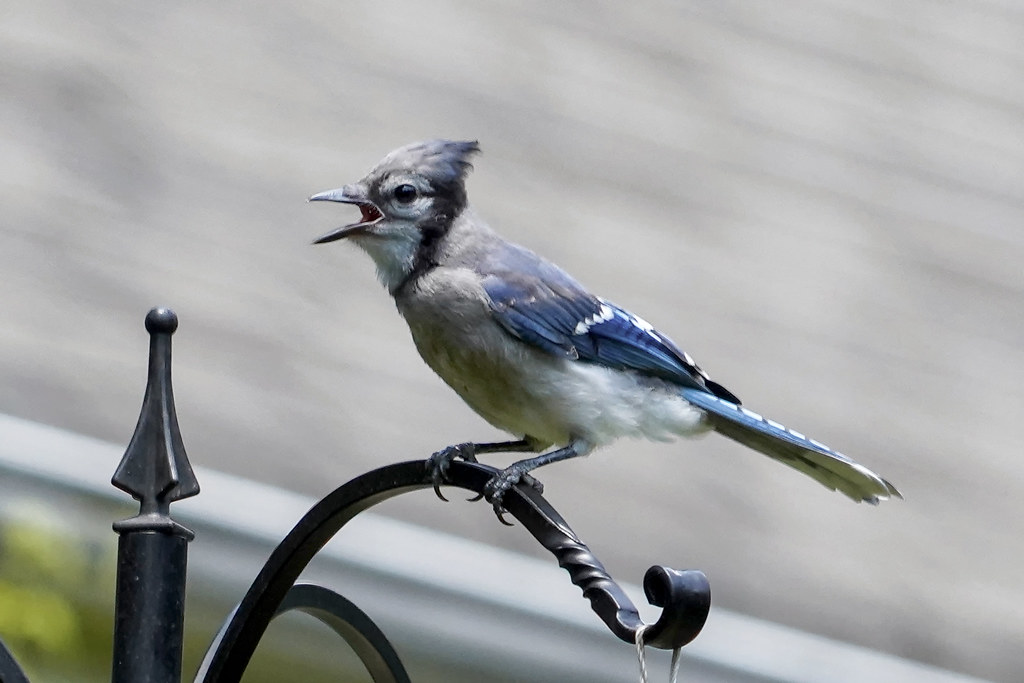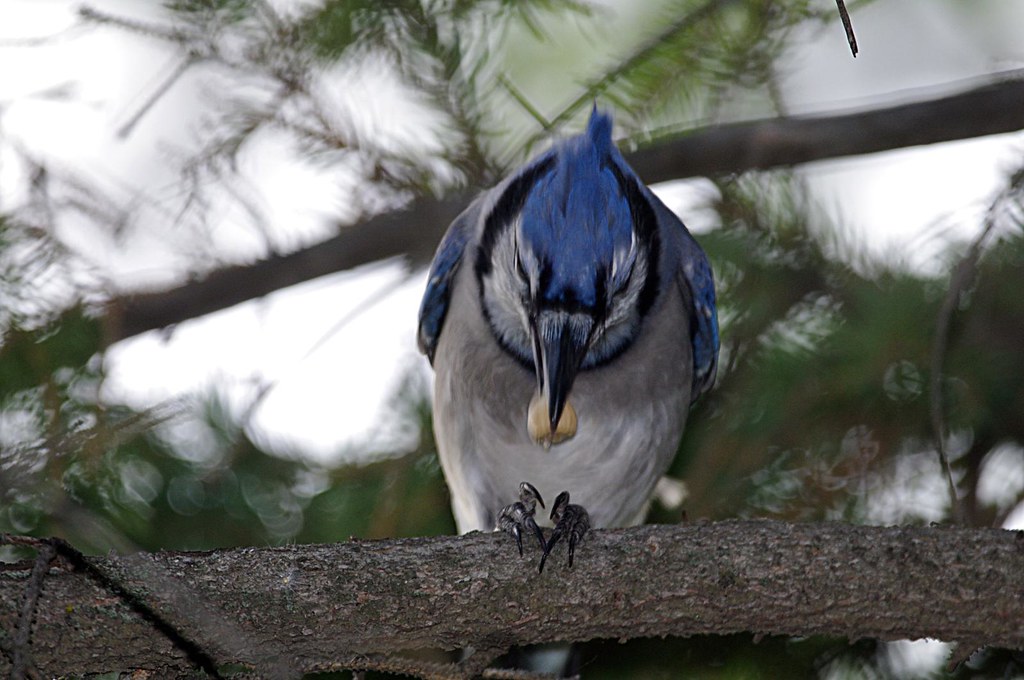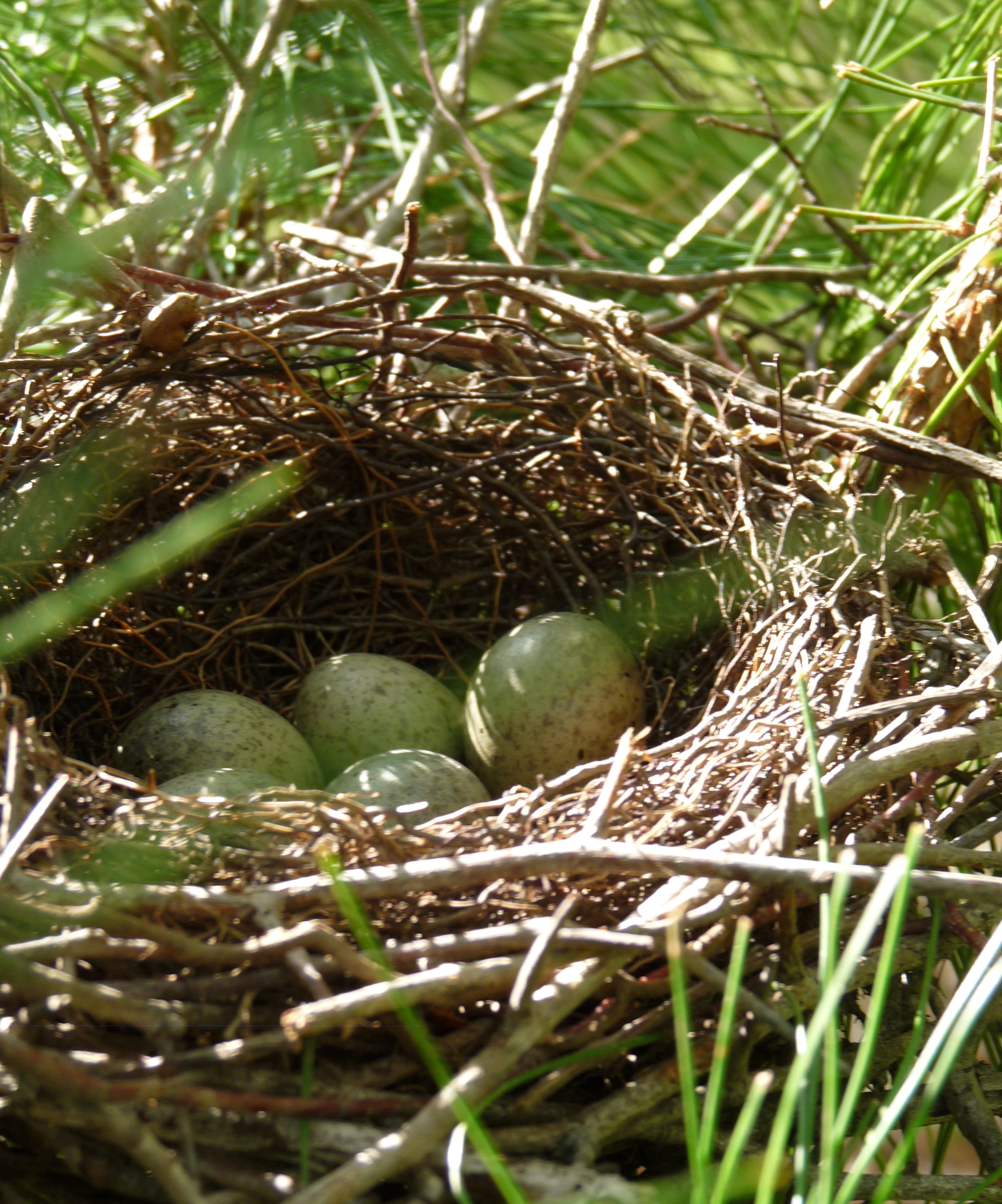Wonders of Wildlife: Blue Jay
Blue Jay
Scientific Name: Cyanocitta cristata
Found in Alabama: Year-round, statewide
Diet: Omnivore (eats plants and animals)
Learn more about... |
|
Blue Jay
Wikimedia - Andy Reago & Chrissy McClarren
Click image to enlarge it |
| CLASSIFICATION |
| |
|
|
What type of animal am I?
- I am a vertebrate (an animal with a spine or backbone).
- I am warm-blooded, so I can control my body temperature.
- I have feathers on the outside of my body that keep me warm.
- I breathe with lungs just like you.
- I have 2 legs.
- I have wings.
|
Scientists use basic traits to group animals into different taxonomic classes.
For a taxonomic classification chart comparing key traits of common backyard wildlife,
CLICK HERE! |
|
| The Blue Jay is a BIRD! |
| IDENTIFICATION TIPS |
| |
|
|
Size:
|
- Relatively large songbird
- Adults range in length from 9.8 - 11.8 inches
- Weigh 2.5 - 3.5 ounces
- Wingspan is 13.4 - 16.9 inches
|
| |
|
|
Key
Characteristics:
|
- Blue, black, and white in coloration
- Mostly blue on the backside with black bars on the wings and tail
- Underside is white or grayish white
- Wings have a thick white wingbar
- Tail and wings are tipped with white
- Collar of black feathers across the throat
- Prominent crest (feathers on head) on head and long tails
|
Blue Jay
Dreamstime
Click image to enlarge it |
| |
|
|
Young: |
- Similar in appearance to adults
- Black markings on head are duller in color
- Coloration appears more pale or muted overall
- Dark bars on wings are less distinct
|
Juvenile Blue Jay
flickr - greylock
Click image to enlarge it |
| ADAPTATIONS |
| |
| PHYSICAL ADAPTATIONS |
| |
| Blue jays have strong beaks for cracking seeds: |
- Blue jays eat acorns and other large seeds and nuts.
- They use their strong bills to crack open nuts.
- While working to crack open the seeds or nuts, they hold the nut with their feet to keep it in place.
|
Blue Jay Cracking Seed
flickr - Kurayba
Click image to enlarge it
|
| Birds can fly: |
- Birds have feathers on their wings rather than hair like humans. Feathers are light, waterproof, and are adjustable for flight control.
- Birds have lightweight beaks instead of heavy jaws and teeth like humans.
- Most bones in their bodies are hollow or honeycombed, making them very lightweight. Some of their bones are fused for increased efficiency and lighter weight.
- Birds have a larger and more efficient respiratory system than humans do since flight is a physically-demanding activity.
|
| |
| Birds can digest whole prey: |
- Birds do not have teeth and are not able to chew food. Because of this, they have a specialized part of their stomach, called a gizzard, that helps with digestion by grinding food.
- The small stones, sand, and grit that birds pick up while they are eating are stored in the gizzard.
- Once food is swallowed and makes its way to the gizzard, it is pulverized by the grit and stomach muscles.
- Some birds like chickens, ducks, and turkeys have thick, muscular gizzards. Other birds that eat food items that are easy to digest, such as nectar and soft-bodied insects, have thin-walled gizzards.
|
| |
| BEHAVIORAL ADAPTATIONS |
| |
| Blue jays are diurnal: |
- They are active during the day (diurnal).
|
| |
| Blue jays mimic hawk sounds: |
- Blue jays communicate with one another using a variety of different calls.
- One of the most recognizable calls of the blue jay is its "jay" call which mimics the sounds that hawks make, particularly the red-shouldered hawk.
- They make this sound as a warning to let other blue jays know that a larger predator (animal that eats them) or threat is in the area.
- They also may make this sound to trick other animals into believing that a hawk is nearby or to scare other species away from a food source.
|
| |
| Blue jays store food: |
- Blue jays will cache or hide acorns during the winter.
- At one time, they can hold 2-3 acorns in a special pouch in the throat called a "gular pouch", one acorn in their mouth, and one acorn in the tip of their beak allowing them to carry up to 5 acorns to a cache site.
- A single blue jay can cache 3,000-5,000 acorns in one season.
- Not only does this ensure that the blue jay will have food throughout the winter, but by removing and hiding food sources from an area, other species or competitors may be deterred from entering the area.
|
| |
| Blue jays are aggressive toward threats: |
- Blue jays are known to be aggressive birds towards threats or predators (animals that eat them), especially during the breeding season.
- To protect the nest or young, blue jays participate in a mobbing behavior in which they swoop towards, chase, and sometimes strike at the larger animal.
- They will often use this behavior against larger birds like hawks, falcons and owls as well as raccoons, squirrels, larger snakes, and domestic cats.
|
| LIFE CYCLE |
| |
|
|
| Life Cycle Stages of the Blue Jay |
| |
|
|
Nest: |
- Open cup nest is made of twigs, bark strips, grasses, leaves, and other plant materials.
- Males and females work together to construct the nest. females tend to spend more time building while males spend more time gathering materials.
- Mud is often incorporated into the nest during construction.
- Nest is lined with rootlets or with wet or decomposing leaves.
|
Blue Jay Nest
Wikimedia - Jeff the quiet
Click image to enlarge it |
| |
|
Eggs: |
- Females lay 2-7 hard-shelled eggs per clutch.
- Eggs are pale blue with brownish spots. Each egg is just over an inch long and just under an inch wide.
- They usually have one clutch each year.
|
| |
|
|
Young: |
- Females incubate (sit on to keep warm) the eggs for 17-18 days.
- Young are born with no feathers.
- Juvenile feathers begin growing in after one week and are completed around 43 days after hatching.
|
| |
|
|
Life Span: |
- Can live up to 7 years in the wild.
|
NATURAL
Habitat Needs |
ADULTS |
YOUNG |
| Food |
- Mainly feed on nuts and insects.
- They prefer to eat larger nuts and seeds such as acorns, beechnuts, hazlehuts, hickory nuts, and other hard masts.
- Consume grain, berries, and other small fruits.
- They will feed on small invertebrates (animals without a spine or backbone).
- THey will sometimes scavenge on dead vertebrates (animals with a spine or backbone) or raid the nests of smaller birds for eggs or young.
|
- While the female sits on eggs or sits with young to keep them warm, the male brings food items back for the female and for the young.
- They feed the young the same food items eaten by the adults.
- Female sits with the young for 8-12 days, and young will remain in the nest for up to 3 weeks.
|
| Water |
- They will drink from sources of freshwater such as ponds or slow moving streams.
- They will also drink droplets of water from vegetation.
|
- Hydration is obtained through food sources.
- They will drink from streams and ponds once they have fledged (left) from the nest.
|
| Shelter |
- Prefer to live near forest edges or woodlands with clearings.
|
- Young remain in nest for up to 3 weeks.
|
| Places to Raise Young |
- Build nests in thicker parts of branches or where a branch meets the tree trunk.
- Nests are usually 10-25 feet off the ground.
|
|
BACKYARD
Habitat Needs |
ADULTS |
YOUNG |
| Food |
- Plant trees that provide a larger seed such as beech trees, oak trees,or hickory trees.
- They will visit tray or hopper feeders filled with larger seeds like peanuts, sunflower seeds, or suet.
|
- Provide food sources for the parents, as they feed the young.
|
| Water |
- Provide a birdbath if a stream or pond is not located nearby.
|
| Shelter |
- Create open habitat with few trees.
- Plant native trees and shrubs near an open area.
|
- Do not remove materials that parents might use to make nests such as twigs and grass clippings.
|
| Places to Raise Young |
- Provide habitat with established trees in which parents can build their nests.
- Plant native trees and shrubs.
- Do not remove small twigs and grass clippings.
|
|
| ECOLOGICAL ROLE |
| |
|
| Animals play an important ecological role in the health of habitats and ecosystems. |
| |
|
Food Source: |
- Adult blue jays are a food source for birds of prey including hawks, owls, and falcons.
- Blue jay eggs are often consumed by squirrels, American and fish crows, snakes, and raccoons.
|
Predation by cats is the number one direct, human-caused threats to birds in the U.S. and Canada. In the U.S., as many as 2.4 billion birds are killed by cats each year.
To read more about this,
CLICK HERE! |
|
| |
|
Seed Dispersal: |
- Acorns from oak trees are a main source of food for blue jays.
- Blue jays often cache (hide orstore) acorns by burying them under leaf litter or in shallow burrows during the winter to ensure that they have a food source.
|
| |
- However, sometimes the blue jays do not consume all acorns that have been stored, giving those seeds an opportunity to grow in their new location.
|
INFORMATION SOURCES FOR THIS SPECIES
.
 Wildlife Tag
Wildlife Tag
